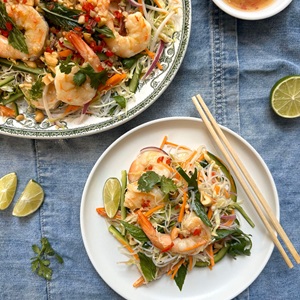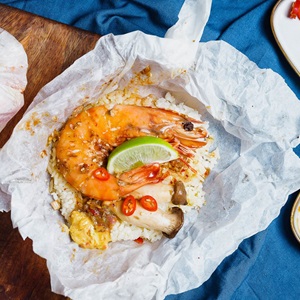Discover what makes the perfect Christmas prawns with delicious prawn recipes, where to buy Australian prawns and tips on how to peel a prawn.
What makes the perfect Christmas prawns
Prawns are synonymous with Christmas in Australia, so we teamed up with YouGov to find out more. The research confirmed that prawns are a firm favourite on the Christmas table in Australia. So much so that 8 million of us would happily forego a glass of Champagne on Christmas Day in favour of eating prawns. Despite this, most of us can agree that prawns can be messy, especially the shells, and they certainly have to be enjoyed right away rather than making up leftovers.
So, what makes the perfect Christmas prawns? The vast majority of us prefer our prawns at Christmas to be served up retro and traditional. We also love our prawns wild-caught, sustainable and from Australia. To be sure, look for the MSC blue fish tick.

The top six ways to enjoy prawns at Christmas
- Chilled and peeled prawns
- Prawn cocktail
- A classic prawn dip
- Barbecued prawns
- Grilled prawns
- Butterfly prawns with the tail on
As for what people search for online, Garlic Prawns recipe is the most searched for prawn recipe at Christmas.

Buying Australian prawns for Christmas
When you buy prawns, they'll either be frozen, cooked or raw.
- Raw: Raw prawns vary in colour and should look almost translucent. Make sure there are no dry or cracked shells.
- Cooked: Make sure the shells are firm with the eyes still intact.
- Frozen: This can be a convenient option and a good way to stock up ahead of Christmas. But always remember to defrost thoroughly before using.
You'll find Australian prawns with the MSC blue fish tick label in the chilled and frozen aisles of your local supermarkets such as Coles and Woolworths. Plus, at specialist fish shops such as Mures Tasmania and Harley & Johns Seafood.
Products are subject to availability.
Buy sustainable prawns at Coles

Karumba Thawed Raw MSC Banana Prawns by weight

Karumba Banana Prawns 500g
Buy sustainable prawns at Woolworths

AGRIOS Wild Banana Prawn Meat 500g

AGRIOS Wild Whole Banana Prawns 1kg

Ocean Chef Australian Raw Peeled Prawns 400g
MSC certified sustainable prawns direct from Austral Fisheries
Skull Island Tiger Prawns
Skull Island Tiger Prawns are the biggest prawns in Australia, each measuring up to ~22cm in length and ~80g in weight. Frozen fresh within 45 minutes of being caught, these behemoths keep their delicious sweet flavour and remain tender. Available in various sizes.
Delivery is throughout Brisbane, Perth, Sydney, and Melbourne only.
32 mouth-watering Christmas prawn recipes
Browse our mouth-watering Christmas prawn recipes created by chefs from around the world, including BBQ prawns, cold starters like a classic prawn cocktail and prawn salads, prawn curries, prawn toasts, prawn crackers, prawn spring rolls, prawn sandwiches and more.
Plus, find out how to BBQ prawns. Our handy guide to barbecuing prawns and lobster includes tips and hacks on how to make use of the whole prawn including using the prawn shells and prawn heads for stock.


How do I know if my Christmas prawns are sustainable?
Over two-thirds (69%) of all wild-caught prawns in Australian waters are MSC certified sustainable.
Sustainable prawns have been caught in a way that means there’s plenty more in the sea now and in the future.
Just look for the MSC blue fish tick label. You'll find the label either on the packaging, menu or seafood counter ticket.

The price shown is illustrative and subject to change.
Where do Australian prawns come from?
In Australia, the following leading Australian prawn fisheries are certified as sustainable to the MSC Fisheries Standard. Prawns with the MSC blue fish tick label are traceable to an MSC-certified sustainable prawn fishery.
Sustainable prawn fisheries in Australia
- Australia Northern Prawn fishery
- Spencer Gulf King Prawn fishery
- Shark Bay Prawn fishery
- Exmouth Gulf Prawn fishery
- Australia East Coast King Prawn fishery
- Australia Royal Red Prawn fishery
Together, these MSC-certified sustainable fisheries account for over two-thirds (69%) of all wild-caught prawns in Australia. We think that’s a cause for celebration.
Dive into the incredible stories of these four pioneering Aussie prawn fisheries
Why is it important to purchase sustainable prawns?
Purchasing sustainable prawns means you are helping to ensure plentiful supplies for future generations, and what would a future Christmas without seafood be like!A third of all fish populations are overfished. With a growing world population, we need to fish sustainably. Your choice encourages more fisheries to voluntarily improve their fishing and become certified as sustainable.
That’s why we are calling on all Australians to help safeguard prawns for future Christmases by shopping sustainably and looking for the MSC blue fish tick label in store and talking to your seafood retailer.

Prawn vs shrimp - what's the difference?
It's easy to get confused between shrimp and prawns. Are they just different names for the same thing? Or completely different things? Why do we 'throw a shrimp on the barbie'?
The difference between prawns and shrimps explained
- They're different species: Both shrimp and prawns are Decapod crustaceans, meaning they both have ten legs and possess external skeletons. However, shrimp belong to the sub-order Pleocyemata, while prawns belong to the sub-order Dendrobranchiata.
- They have different anatomies: Prawns have claws on three pairs of their legs and second pincers that are larger than their front ones, whereas shrimp have claws on two pairs of their legs. Prawns also lack the distinct bend in their bodies that is seen with shrimp and each of their body segments overlaps the one behind it in succession.
- Shrimp and prawns are different sizes: Shrimp are smaller than prawns in most cases and that's certainly the case with Jumbo Tiger Prawns.
Do sustainable prawns cost more?
As with anything if demand increases and supplies dwindle, the price will increase. If we want to continue eating prawns at an affordable price in the future, we must act now.
Sustainable wild-caught prawns are available at a range of prices that are good for your pocket and the ocean too. Shop around and look for the MSC blue fish tick label to be sure you’re buying sustainably.
Get the most out of your wild-caught prawns. By reducing waste and making use of the whole prawn, you'll get better value for money.
So, the bigger question is can we afford not to buy sustainable prawns?
How to peel a prawn
- Remove the head
- Place your thumb underneath the legs of the top three sections and click them off
- Remove the bottom two sections and then pinch the tail
- Peel off the intestinal tract
How to peel a prawn in under 30 seconds
Types of prawns
Common wild-caught species in Australia include:
- banana prawns (red or white),
- tiger prawns (brown or grooved),
- king prawns (eastern and western),
- endeavour prawns (blue or red).
Find out more about wild-caught sustainable prawns in Australia.
Choose the right kind of Australian prawn species for your style of cooking.
How to tell if prawns are off
It is unsafe to eat prawns that are off. If they are, they should be thrown away.
Signs that your prawns are off:
- Smell: sour, overly fishy
- Look: slimy, dull
How to defrost your prawns
According to chef Courtney Roulston, prawns should never be defrosted at room temperature.
Put frozen prawns in a bowl of cold water salted to taste like the ocean (2 tablespoons per litre) and place on the bottom shelf of the fridge, and leave it overnight or around 12 hours.
Keeping the prawns submerged under water keeps any direct air away from them and prevents them from oxidising or the heads turning black!
The best way to defrost your prawns
How to store prawns
It is always best to purchase prawns near the day you plan to serve or cook them. If that can't be done, here are some options.
Storing prawns correctly is important, and do refer to the packaging and ask your fishmonger for advice too.
- Fresh and cooked prawns: can be kept for up to three days in an airtight container in the coldest part of the fridge.
- Whole uncooked prawns: keep in their shell and only peel up to a few hours ahead of cooking
- Frozen prawns: it is important to thaw before using. Defrost by placing frozen prawns in an airtight container and leaving them in the fridge overnight. Rinse with cold water before using
The best way to store your prawns
How to cook prawns
Prawns can be cooked with or without their shells. They can be cooked on the barbecue, in a pan or on the grill individually or on skewers. Cooked prawns are simple:
- Cook for 2 minutes on each side until the flesh turns opaque
- Alternatively, purchasing cooked prawns requires no cooking
Why do we eat prawns at Christmas in Australia?
Eating prawns at Christmas is an Australian tradition for the following reasons:
- The warm weather: Christmas in Australia is Summertime. That means being outside, cooking on the barbecue and not adding loads of heat to your home by using the oven
- Prawns are a treat: Christmas is about celebration and indulgence. Prawns are a tasty treat, not an everyday item.
- Seasonality: The prawn fishing season in Australia begins in August meaning prawns are in season at Christmas
- They're Australian: Australian waters are home to many amazing species of prawns including tiger prawns, banana prawns and king prawns.
- Easy to prepare: Christmas can be hectic and cooking prawns is quick and easy
Teach and learn about prawns at Christmas
Learn about prawns with our curriculum-aligned teaching resources for the classroom. Complete with lesson plans, activities, games and quizzes.
View and download the free Christmas teaching resources

Find out more

What is sustainable fishing?
Sustainable fishing means leaving enough fish in the ocean, respecting habitats and ensuring people who depend on fishing can maintain their livelihoods.

Is seafood with the blue fish tick really sustainable?
You can trust that seafood with the blue fish tick was caught by a responsible fishery in a sustainable way.

How does the MSC label compare?
There are many labels out there, so how does the blue fish compare with others?
Your guide to sustainable seafood
Find out where to buy, what to look for and the questions to ask.











.tmb-thumb300.jpg?Culture=en-AU&sfvrsn=826a6414_1)
.tmb-thumb300.png?Culture=en-AU&sfvrsn=70197b74_1)
























